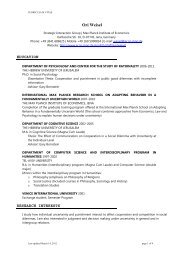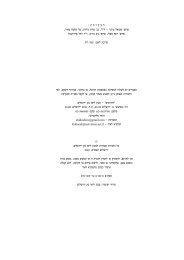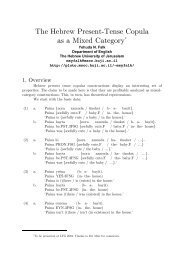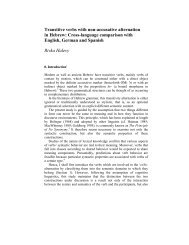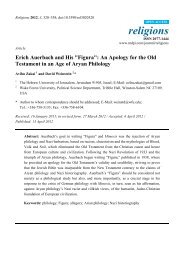The Federal Reserve May Be Politically ... - Pluto Huji Ac Il
The Federal Reserve May Be Politically ... - Pluto Huji Ac Il
The Federal Reserve May Be Politically ... - Pluto Huji Ac Il
Create successful ePaper yourself
Turn your PDF publications into a flip-book with our unique Google optimized e-Paper software.
the fed may be politically independent,<br />
but it is not politically indifferent<br />
William Roberts Clark ∗<br />
Vincent Arel-Bundock †<br />
June 6, 2011<br />
<strong>Be</strong>fore the advent of positive political economy and public choice economics,<br />
text-book macroeconomic models assumed policy was controlled by benevolent planners<br />
seeking to maximize social welfare (e.g. full employment, economic growth<br />
and price stability). Over the last few decades, however, the aforementioned schools<br />
have chipped away at the idea that the self-interested actors that inhabit our models<br />
of rms and households magically become social welfare maximizing saints when<br />
they enter public service. Positive political economy models have typically replaced<br />
benevolent social planners with survival or vote maximizing politicians. ese politicians<br />
may have policy goals, but they must weigh these goals against the fact that retaining<br />
office is oen a necessary condition for them to even achieve their objectives.<br />
e positive political economy of monetary policy, however, represents a partial<br />
exception to this trend. Analyses of the time inconsistency problem in monetary policy,<br />
for example, retain benevolent social planners to demonstrate the robustness of<br />
the problem: discretionary policy leads to higher than optimal ination rates even if<br />
we are fortunate enough to have an economy run by benevolent social planners (Kydland<br />
and Prescott (1977), Barro and Gordon (1983)). Elected politicians are thought<br />
to be particularly sensitive to the political pressures that ensue when output falls below<br />
the natural rate. ey are, therefore, keen to trade increased ination for output<br />
gains. is generates a time inconsistency problem - if politicians could commit to a<br />
low ination rule, they would be able to produce an outcome closer to the social optimum,<br />
but short-term political pressures, perhaps induced by the electoral calendar,<br />
make such commitments incredible.<br />
∗ Professor of political science, University of Michigan<br />
† PhD student, Department of political science, University of Michigan<br />
1
One solution (Rogoff, 1985) is to appoint a central banker whose preferences over<br />
ination are sufficiently hawkish to produce, somewhat unwittingly, a socially desirable<br />
outcome aer it too falls victim to the time inconsistency problem. Another<br />
(Walsh, 1995) is to write a contract between the political principal and the central<br />
banker that ties the banker’s compensation to its ability to meet predetermined policy<br />
goals. 1 In the Rogoff model, elected officials who delegate to a conservative central<br />
bankers are essentially strategic benevolent social planners. Like Odysseus, they tie<br />
themselves to the mast and resign their fates to slaves with wax in their ears in order<br />
to accomplish what they could not achieve on their own - the optimization of a social<br />
welfare function. In the Walsh model, elected politicians with the song of sirens in<br />
their ears nevertheless enshrine the actions of the benevolent social planner in the<br />
optimal contract they sign with a central banker who is a sufficiently good wage slave<br />
to do what he or she is told.<br />
Canonical models of central bank independence, then, take one step forward and<br />
one step back. ey treat politicians as electorally-minded strategic actors capable of<br />
designing institutions that trick central bankers into producing policies preferred by<br />
the median voter. But they assume that central bankers are apartisan technocrats who<br />
optimize within the constraints created by their political principals without considering<br />
how the choices they make today can shape the political environment tomorrow.<br />
In this paper, we consider what happens when the positive political economy approach<br />
is applied more fully to the political economy of central bank independence.<br />
What if both the elected principal and the central banker look and act like the individuals<br />
in our models of rms and households? Our answer is that strategic, conservative<br />
central bankers should behave as conditional ination hawks. ey should be less responsive<br />
to inationary pressures when the incumbent politicians have preferences<br />
similar to their own.<br />
We analyze data on half a century of Fed policy to evaluate our argument. We<br />
nd that the Fed raises interest rates as elections approach when Democrats control<br />
the White House, but lowers interest rates as elections approach under Republican<br />
administrations. Furthermore, when Democrats control the White House, the Fed<br />
lowers interest rates in response to increased inationary expectations, especially as<br />
elections approach, but it is insensitive to the gap between actual and potential output.<br />
In stark contrast, when Republicans are in office, the Fed lowers interest rates<br />
as the economy enters a recessionary period- especially as elections approach - and<br />
is insensitive to inationary expectations. ese results are consistent with the idea<br />
that the Fed prefers Republican presidents, and that it acts to help ensure their election<br />
and re-election. Anecdotal evidence suggests that the political independence of<br />
1 ough it is not clear to us why the principal’s threat to punish the agent for behaving as it would<br />
behave are credible.<br />
2
the Fed allows it to act effectively in light of its political preferences: Republicans were<br />
much more effective in gaining and keeping the White House in the half-century aer<br />
the Fed became operationally independent than in the period preceding operational<br />
independence.<br />
In the next section we explain why the Fed could prefer that the White House be<br />
controlled by Republicans, and we discuss why this should lead it to act like a conditional<br />
ination hawk. In section 2 we present evidence that the Fed Funds Rate (FFR)<br />
is tied to the electoral calendar and that that this link is different when Republicans<br />
control the White House and when Democrats do. In section 3 we present evidence<br />
that the Fed’s reaction to ination and the output gap depends on both the election<br />
calendar and the partisan orientation of the White House. Section 4 summarizes our<br />
results and describes changes in the presidential electoral fortunes of the two parties<br />
during the (near) century since the creation of the Fed.<br />
1 why the fed is a conditional inflation hawk<br />
We argue that the Fed manipulates monetary policy in a partisan fashion. In this<br />
section we articulate two steps of our argument. First, we explain why the Fed cares<br />
which party rules. Second, we show why this leads the Fed to respond to electoral<br />
and macroeconomic pressures in a manner that is conditioned by the party of the<br />
president.<br />
1.1 If Parties Have Monetary Preferences, Conservative Central Bankers Have<br />
Partisan Preferences<br />
e standard partisan model of monetary policy assumes that political parties represent<br />
constituencies with distinct preferences over ination and unemployment (cites).<br />
One way to think of this is that net debtors are less concerned with ination than net<br />
creditors and, so, place a greater weight on achieving their output goals than their<br />
ination goal. Even if both actors had the same output goal, the amount of ination<br />
they would be willing to tolerate to accomplish that goal would differ. For example,<br />
imagine citizen i ′ s policy preferences were given by the loss function:<br />
Li = α(π − π ∗ ) 2 + (1 − α)(y − y ∗ ) 2<br />
where y is output, y ∗ is i’s output target (perhaps potential GDP) , π is ination and π ∗<br />
is i ′ s ination target. Assume, without the loss of generality, that all citizens in society<br />
share target rates for output and ination (perhaps potential GDP and zero ination).<br />
Individuals would still differ in their assessment of outcomes if they placed different<br />
weights on hitting these targets. Individuals with α < .5 care more about hitting<br />
3
Figure 1: Spatial relationship between central bankers and parties<br />
L R CB<br />
0 1<br />
Weight on ination<br />
their output target than hitting their ination target, and vice versa for individuals<br />
with α > .5. Holding ination constant, actors can be arrayed along a unit interval<br />
from α = 0 (output junkies) to α = 1 (ination hawks). e partisan model of<br />
monetary policy assumes that le wing parties represent the interests of voters with<br />
lower incomes who care more about output than ination, placing them on the lower<br />
end of this unit interval. Right wing parties are thought to represent high income<br />
individuals who care more about ination than output, placing them on the upper<br />
end of this unit interval. e desire to represent the interests of voters in their natural<br />
constituency induces ideal points for le and right-wing parties as pictured in Figure<br />
1.<br />
e Rogoff model of central bank independence maintains that the time inconsistency<br />
problem in monetary policy can be overcome if politicians delegate policy to<br />
a central banker who is even more ination adverse than right wing politicians. us<br />
central bankers will have alpha’s that place them to the right of right wing parties as<br />
in gure 1.<br />
ere are reasons to believe, however, that even independent central bankers will<br />
not be able to implement their ideal point. McCubbins and Schwartz (1984) argue<br />
that executive agencies granted with autonomy need to be mindful of the fact that<br />
the legislature that grants that independence can also take it away. Helge <strong>Be</strong>rger and<br />
Friedrich Schneider (2000) showed that the Bundesbank’s policies moved in parallel<br />
with changes in the composition of the Bundestag. Keefer and Stasavage (2003)<br />
would predict this sort of sensitivity to changes in the composition of the body since a<br />
change in the composition of government is likely to lead to a change in the reversion<br />
point - the policy that the government would implement in the absence of independence<br />
- should the implicit bargain between the government and the central bank fail.<br />
A rational central banker will seek to deter the government’s abrogation of the agreement<br />
that led to his or her independence and will, therefore, adopt a policy that is as<br />
close to its ideal point as possible, subject to the constraint that the political coalition<br />
needed to abrogate independence needs to be at least indifferent between the policy<br />
adopted by an independent central bank and the policy that would prevail in the ab-<br />
4
sence of independence. e exact position adopted by an independent central banker<br />
will, therefore, be inuenced by the political institutions that dictate what is necessary<br />
to change the status quo - including, executive legislative relations, the presence of a<br />
second house, super majority requirements, and whether the government is a coalition<br />
or single party government. But, in general, if the central banker’s ideal point<br />
is to the right of the right most party, the best it can do in the short run is move to<br />
the le when the a le wing party comes to power and to the right when a right wing<br />
party comes to power. At the very least, we can expect policy to be somewhere in<br />
the interval beween R and CB when there is a right-wing government in power and<br />
L and CB when there is a le wing government in power (see Figure 1). If central<br />
banks are (at most) partially independent, then we can think of equilibrium policy as<br />
being some convex combination (determined by the degree of independence) of the<br />
ideal points of the government and the the central bank Franzese (1999). While, for<br />
all the reasons just stated, it is difficult to predict exactly where the optimal short run<br />
policy is for the central banker none of the above qualications challenge the notion<br />
that to the extent that the central bank is independent, we can expect policy to be<br />
somewhere between the government’s ideal point and the bank’s ideal point and this<br />
location should be closer to the central bank’s ideal point when a right wing government<br />
is in power.<br />
1.2 Central Bankers with Partisan Preferences Have Incentives to Try to In-<br />
uence Elections<br />
So far our discussion suggests that we ought to observe uctuations in interest rates<br />
in the United States that are consistent with the traditional partisan model. e Fed<br />
should guard its independence by accommodating le wing policies as the political<br />
center of gravity moves to the le, and it is free to adopt a policy closer to its ideal<br />
point as the center of gravity moves to the right. An alternative model, the political<br />
business cycle model, presumes that politicians are responding to a homogenous<br />
electorate that votes in a myopically retrospective fashion - they vote for incumbents<br />
that produce short-term macroeconomic expansions just before elections, and vote<br />
for challengers when no expansion occurs (cites to economic voting lit? up to and<br />
including Duch and Stevenson). Alpanda and Honig (2009), Clark et al. (1998) and<br />
Clark and Hallerberg (2000) argue that central bank independence ought to inhibit<br />
politician’s ability to engage in this sort of opportunistic behavior, though Alpanda<br />
and Honig nd more evidence for this constraining effect of central bank independence<br />
in developing countries than they do in developed countries.<br />
However, if central bankers are aware of the fact that parties of both stripes will<br />
be under some pressure to engage in pre-electoral expansions and that voters will<br />
reward them for doing so, they may have incentives both to help right-wing parties<br />
5
engage in such expansion and to frustrate attempts by le-wing parties to do so. In<br />
effect, central bankers in such a world face an inter-temporal trade-off when rightwing<br />
government are in power. ey can push for the policy closest to their ideal<br />
point in the feasible set knowing that doing so decreases the likelihood that the rightwing<br />
party gets re-elected, or they can accept a more expansionary policy now in<br />
exchange for an increase in the probability that the government in power during nonelectoral<br />
times will be closer to its ideal point. 2 In contrast, when le-wing parties are<br />
in power, a conservative central banker faces no such dilemma. Political preferences<br />
align with the Fed’s well publicized commitment to price stability since the political<br />
consequence of following through on that commitment is an increase in the probability<br />
that a government with an ideal point closer to its own will get elected. us,<br />
we can expect independent central banks to act like conservative independent central<br />
banks - but only when le-wing governments are in power. When the party(ies)<br />
the central bank favors are in power, the central bank should be more willing to accommodate<br />
pre-electoral expansions, that is, it should act in the fashion traditionally<br />
associated with dependent central banks. It is important to note, however, that this<br />
conditional accommodation is not evidence of a lack of independence. Far from it.<br />
It is evidence that the bank is using its independence to act on the fact that it is not<br />
indifferent.<br />
1.3 Caveats<br />
So far we have assumed that independent central bankers have conservative preferences<br />
over monetary policy, but we have not explained why they would hold such<br />
preferences. We can invoke three reasons to justify this assumption. First, according<br />
to the logic of the Rogoff model, central bank independence is created in order<br />
to overcome the time inconsistency problem that plagues monetary policy. If those<br />
who grant independence to the bank do so for this reason, it would not make sense<br />
to appoint anyone other than an ination hawk. Some might nd it anachronistic to<br />
attribute this chain of reasoning to political principals operating decades before Kydland<br />
and Prescott, Barro and Gordon, and Rogoff, but there are other reasons why<br />
central bankers might be conservative. Monetary policy is a technical endeavor and<br />
exercising effective leadership of a central bank without a solid command of the economics<br />
of nancial markets is highly unlikely. us, central bankers are likely to be<br />
2 Another interpretation of the situation is that right-wing parties become “as if l” they were a lewing<br />
party as elections approach and central banks are merely responding to a new ”reversion” point -<br />
the point that the right wing government is implicitly threatening to implement if the central bank does<br />
not accommodate their temporarily expansionary wishes. But if this was what was going on, the central<br />
bank should also become more expansionary when elections draw near when le wing parties control<br />
the government.<br />
6
drawn from an epistemic community with close ties to nancial rms. In other words,<br />
central banks are prone to “industry capture.” If one accepts Posen (1995) argument<br />
that members of the nancial community have reasons to have anti-inationary preferences,<br />
the selection process of central bankers makes it likely that they will be “conservative”<br />
in the Rogoffian sense. Finally, while Adolph (2005) is careful to point out<br />
that “independent” need not mean “conservative” he argues that central bankers may<br />
adopt ideological positions that will be favored by future employers. If the future employment<br />
possibilities for central bankers come overwhelmingly from nancial rms,<br />
Adolph (combined with the Posen thesis) provides a forward-looking rationale for<br />
central bank conservatism.<br />
Another possible objection is that while “le” and “right” wing may be appropriate<br />
labels for comparing socialist and business-oriented parties in western Europe,<br />
when viewed in a comparative context, Republicans and Democrats are best thought<br />
of as relatively similar “center-right” parties. is may be true, but all that is necessary<br />
for our model is that the parties differ in their propensity to represent antiinationary<br />
constituencies. Our expectations are driven by the ordinal ranking of<br />
expected policies in the mind of the central bank, not the magnitude of the difference.<br />
Yet another concern may be justiably raised about the impact of divided government.<br />
Fiscal policy, for example, is driven by congress as well as the president and,<br />
unlike parliamentary systems in Europe, when there is a partisan change in head of<br />
government in the U.S. it does not mean that partisan control of government has necessarily<br />
changed. In other words, maybe the Fed cares as much about who controls<br />
congress as it cares about who controls the White House. And if that is true, ought<br />
we not be as concerned about the Congressional electoral calendar as the Presidential.<br />
ese are valid concerns but will, for the moment, be treated as plans for future<br />
extension.<br />
2 the conditional link between the electoral calendar<br />
and the fed funds rate<br />
e traditional political business cycle argument implies that if monetary policy is<br />
under the sway of politicians, interest rates ought to be lowered as elections draw<br />
near (solid lines in Panel (a) of Figure 2). Existing attempts to add central bank independence<br />
to this picture suggest that independence ought to dampen this effect<br />
- there should be little or no link between interest rates and the electoral calendar<br />
(dashed lines in Panel (a) of Figure 2). e traditional partisan model of monetary<br />
policy predicts that interest rates ought to be higher when right-wing governments<br />
are in power than when le-wing government are in power (solid lines in Panel (b)<br />
7
Figure 2: Hypothesized link between interest rates and the electoral calendar<br />
Interest<br />
rate<br />
Republican<br />
Democrat<br />
CBI<br />
No CBI<br />
Electoralist Partisan<br />
Election proximity<br />
Strategic central banker<br />
(a) (b) (c)<br />
of Figure 2). If the central bank is a neutral ination hawk, then partisan differences<br />
in interests ought to remain, though at a lower rate reecting the unconditional in-<br />
uence of an independent central bank (dashed lines in Panel (b) of Figure 2). Our<br />
model, however, predicts a relationship between the electoral calendar and interest<br />
rates under central bank independence that is distinct from both of these alternatives.<br />
If the central bank is actively engaged in supporting the electoral and re-electoral efforts<br />
of right-wing parties interest rates ought to decrease as elections draw near, if<br />
right-wing parties control the government, but when le-wing parties are in power<br />
interest rates may be seen to increase as elections draw near (dashed lines in Panel<br />
(c) of Figure 2 ). In contrast, in the absence of central bank independence, our model<br />
predicts the same behavior as the traditional PBC model does (solid lines in Panel<br />
(c) Figure 2). In this section, we use data on the <strong>Federal</strong> Funds Rate to evaluate this<br />
claim.<br />
Figure 3 plots the evolution of the <strong>Federal</strong> Funds Rate (FFR) against the electoral<br />
cycle across all presidential administrations since Eisenhower’s rst term in office. 3<br />
e difference between the Democrat and the Republican plots is striking. For every<br />
Democratic term in office, the interest rate path ends at a higher level than it started.<br />
For every Republican president’s term, it ends at a lower rate than it started. Figure 4<br />
tells the same story. e <strong>Federal</strong> funds rate climbs during each Democratic administration<br />
and falls, oen precipitously, before Republican incumbents come up for<br />
3 Data on the FFR were obtained from the FRED database, published by the St.Louis Fed.<br />
8
<strong>Federal</strong> Funds Rate (%)<br />
15<br />
10<br />
5<br />
Figure 3: <strong>Federal</strong> funds rate over electoral cycles<br />
Democrat<br />
Republican<br />
2 4 6 8 10 12 14 16<br />
Quarter<br />
2 4 6 8 10 12 14 16<br />
president<br />
Barack Obama<br />
Dwight Eisenhower<br />
Dwight Eisenhower (2nd term)<br />
George H.W. Bush<br />
George W. Bush<br />
George W. Bush (2nd term)<br />
Gerald Ford<br />
Jimmy Carter<br />
Lyndon Johnson<br />
Lyndon Johnson (2nd term)<br />
Richard Nixon<br />
Ronald Reagan<br />
Ronald Reagan (2nd term)<br />
William J. Clinton<br />
William J. Clinton (2nd term)<br />
LameDuck<br />
1st term<br />
2nd term<br />
re-election.<br />
While the data in Figures 2 and 3 are visually compelling, one objection may be<br />
that the Fed is behaving differently under Democrats and Republicans because underlying<br />
macoeconomic conditions differ when partisan control varies. To ensure<br />
that the pattern identied above is not driven by differences in the underlying economic<br />
conditions to which the Fed is responding. To that end, we estimate models<br />
of the following form:<br />
Ft = +b1E + b2D + b3E ∗ D + b4G + b5π + b6Ft−1 + ΩP + α + ϵ<br />
F is the effective federal funds rate. E is an election counter which equals 1 in the<br />
period that immediately follows a presidential election. E is then incremented by 1 in<br />
every subsequent quarter until it reaches 16. D is a dummy variable equal to 1 when<br />
a Democratic president is in office and 0 otherwise. P is a vector of dummy variables<br />
that correspond to each presidential administration (i.e. 15 electoral cycles).<br />
In addition to the partisan and electoral variables, we control for macro-economic<br />
conditions by including the two Taylor-rule variables: output gap and ination. G is<br />
the output gap, dened as deviation of the real GDP from real potential GDP (%). 4<br />
We estimate models using four alternative measures of ination (π). First, we use the<br />
4 Real potential GDP represents real GDP under conditions of full employment. Estimates are from<br />
the Congressional Budget Office.<br />
9
Figure 4: <strong>Federal</strong> funds rate over time<br />
annualized rate of ination (consummer price index for all urban products). en,<br />
to account for the possibility that the Fed may be forward-looking, we substitute π<br />
for one of three measures of inationary expectations. πe H is the median expected<br />
price change (12 months) obtained from a household survey conducted by the Survey<br />
Research Center at the University of Michigan. πe P is the median 10-year ination<br />
expectation from the Survey of Professional Forecasters (Philadelphia Fed). πe C is a<br />
model-based measure of inationary expecations calculated for the 10-year horizon<br />
by the Cleveland Fed. 5 6<br />
Finally, to ensure that the Fed is not simply responding to differences in scal<br />
policy by incumbent Republicans and Democrats, in some of our models we include<br />
controls for government expeditures to GDP, as well as government debt to GDP.<br />
Sources for the inationary expectations variables are noted above. All other data<br />
are from the FRED database at the <strong>Federal</strong> <strong>Reserve</strong> Bank of St. Louis. All variables<br />
are measured at quarterly intervals.<br />
If our argument is correct, the coefficient on the election variable, which captures<br />
the estimated effect of a movement toward an election when Democrat =0, ought to<br />
be negative and statistically signicant and the coefficient on the interaction term<br />
ought to be positive and large compared to the coefficient on election. Table 1 shows<br />
5 http://www.clevelandfed.org/research/commentary/2009/0809.cfm<br />
6 Models were estimated with various lags on the G and π variables without affecting our conclusions<br />
substantively. ose results are omitted for brevity.<br />
10
that, for the most part, both of these expectations are fullled across a number of<br />
specications. In Model 1 the coefficient on Election is negative and statistically signicant<br />
and the co-efficient on the interaction is positive and roughly twice as large<br />
as the coefficient on Election. is model essentially summarizes the plots in Figure<br />
3: on average interest rates drop over the course of Republican administrations<br />
but increase over the course of Democratic administrations. Row one of Table 2 reports<br />
the marginal effect of a change in electoral quarter in Democratic and Republican<br />
administrations based on Model 1. Note that the condence interval around the<br />
estimated effect under Republican administrations is negative, but the condence<br />
interval around the estimated effect under a Democratic administration is positive.<br />
us, according to Model 1, interest rates go down as elections draw near when Republicans<br />
control the White House, but they go up when elections draw near when<br />
Democrats control the White House. is result is generally robust to the inclusion of<br />
a control for ination (Model 2), and ination and the output gap (Model 3) - though<br />
the interaction term is no longer statistically signicant in the latter case. Table two<br />
shows, that the marginal effect of elections on the FFR when Republicans control the<br />
White House in models 1 to 3, but the effect is positive (models 1 and 2) or at least<br />
non-negative (model 3) when Democrats control the White House. Models 4 and<br />
5 also control for broad measures of the scal balance. In model 5 we control for<br />
both spending as a share of GDP and the Debt-to-GDP ratio and nd results that are<br />
nearly identitical to model 1, except that the standard errors of our main variables of<br />
interest are inated (a result, presumably, of fewer degrees of freedom).<br />
3 the fed’s conditional reaction function<br />
e previous section implicitly assumes that interest rates are driven primarily by<br />
the electoral calendar, modied by the party of the president. is is an extreme<br />
version of our argument. More plausibly, perhaps, the Fed’s reaction function may<br />
be fundamentally similar to the Taylor rule, but strategic considerations may cause<br />
the Fed to deviate from the textbook policies we would associate with a politically<br />
disinterested central bank. If the Fed were operating according to the Taylor rule, it<br />
would raise interest rates in response to increased ination and lower interest rates<br />
in response to an decrease in the output gap. Empirically, we might capture such<br />
behavior with a model such as:<br />
Ft = a1G + a2π + a3Ft−1 + ΩP + α + ϵ<br />
with the expectation that a1 > 0, a2 > 0. If the Fed behaves as an ination hawk,<br />
the coefficient on the output gap would be close to zero and the coefficient on ination<br />
11
Table 1: Relationship between federal funds rate and election cycle, conditional on<br />
the party of the incumbent president.<br />
Model 1 Model 2 Model 3 Model 4 Model 5<br />
(Intercept) 1.968 ∗∗∗ 2.091 ∗∗∗ 1.896 ∗∗∗ 0.545 −1.015<br />
(0.515) (0.487) (0.412) (3.054) (3.812)<br />
FFRt−1 0.797 ∗∗∗ 0.711 ∗∗∗ 0.732 ∗∗∗ 0.736 ∗∗∗ 0.703 ∗∗∗<br />
(0.056) (0.058) (0.050) (0.050) (0.058)<br />
Democrat −2.222 ∗∗∗ −2.488 ∗∗∗ −0.916 −2.187 −3.859<br />
(0.542) (0.535) (0.619) (3.244) (3.152)<br />
Election −0.062 ∗∗∗ −0.061 ∗∗∗ −0.034 ∗ −0.045 −0.078 †<br />
(0.018) (0.017) (0.016) (0.031) (0.041)<br />
Democrat × Election 0.119 ∗∗∗ 0.110 ∗∗ 0.065 0.069 0.119 †<br />
(0.034) (0.034) (0.040) (0.045) (0.061)<br />
π 0.150 ∗∗∗ 0.111 ∗∗∗ 0.110 ∗∗∗ 0.121 ∗∗<br />
(0.033) (0.031) (0.030) (0.037)<br />
Y-gap 0.208 ∗∗∗ 0.225 ∗∗∗ 0.259 ∗∗∗<br />
(0.051) (0.047) (0.065)<br />
Expenditure / GDP 10.046 28.054<br />
(22.807) (37.585)<br />
Debt / GDP −0.171<br />
(0.474)<br />
N 225 225 225 225 179<br />
R 2 0.940 0.945 0.953 0.953 0.948<br />
adj. R 2 0.935 0.940 0.949 0.949 0.942<br />
Resid. sd 0.869 0.832 0.769 0.770 0.836<br />
Robust standard errors in parentheses. Administration dummies omitted.<br />
† signicant at p < .10; ∗ p < .05; ∗∗ p < .01; ∗∗∗ p < .001<br />
would be large. If the Fed is more concerned about shortfalls in output than ination,<br />
the converse would be true - the coefficient on the output gap would be large and the<br />
coefficient on ination would be close to zero. e traditional PBC model would<br />
predict that a dependent central bank would act less and less like an ination hawk<br />
as elections draw near. us, a1 and a2 are conditional on the electoral calendar. In<br />
addition, our argument suggests that the conditioning effect of the electoral calendar<br />
is different when Republicans control the White House than when Democrats do. e<br />
appropriate conditional model, therefore, is:<br />
12
Table 2: Marginal effect of election proximity on federal funds rate.<br />
Democrat Republican<br />
M.E. 90% C.I. M.E. 90% C.I.<br />
Model 1 0.057 [0.011 , 0.103] -0.062 [-0.091 , -0.032]<br />
Model 2 0.049 [0.004 , 0.094] -0.061 [-0.089 , -0.033]<br />
Model 3 0.031 [-0.02 , 0.083] -0.034 [-0.06 , -0.009]<br />
Model 4 0.024 [-0.008 , 0.055] -0.045 [-0.097 , 0.006]<br />
Model 5 0.041 [-0.004 , 0.086] -0.078 [-0.146 , -0.01]<br />
Ft = bππ + bπEπE + bπDπD + bπEDπED<br />
+ bGG + bGEGE + bGDGD + bGDEGDE<br />
+ bEE + bDD + bDEDE + b12Ft−1 + ΩP + α + ϵ<br />
and the conditional effects of changes in ination are given by:<br />
∂<br />
∂π = bπ + bπEE + bπDD + bπEDED (1)<br />
when Republicans are in office (D = 0) this simplies to<br />
13<br />
∂<br />
∂π|D = 0 bπ + bπEE (2)<br />
which is a straight line that summarizes how electoral proximity inuences the relationship<br />
between ination and interest rates when Republicans control the White<br />
House. If our argument is correct, the Fed ought to respond to increased ination less<br />
aggressively as Republican incumbents draw closer to re-election. us, the slope parameter<br />
( the cross derivative bπE) ought to be negative, or at least not positive. Table<br />
3 suggests this is the case - the interaction term Election × π is negative and is statistically<br />
signicant when ination or our measure of expected ination based on<br />
household surveys is used.<br />
When Democrats control the White House 1 simplies to:<br />
∂<br />
∂π|D = 1) = [bπ + bπD] + [bπE + bπED]E (3)<br />
and if out argument is correct, the Fed should respond to increased ination more<br />
aggressively as elections draws near. us, the slope parameter (the cross derivative
πE + bπED) ought to be positive). It is easy to see that in Table 3 the sum of the<br />
coefficients for Election × π and Democrat × Election × π is positive.<br />
Figure 5 plots equations 2 and 3 along with 95% condence intervals for the four<br />
equations in Table 3 - which differ only in the measure for ination used. e positive<br />
slopes on the gray lines suggest that, as the election approaches, the Fed becomes<br />
an ination hawk if a Democrat is in office. e negative slope on the black lines<br />
suggest that the association between interest rates and ination converges to zero as<br />
Republican incumbents near re-election. e slope parameters in 2 and 3 will differ<br />
by the value of the Democrat × Election × π coefficient in Table 3. Note that this<br />
is consistently positive and statistically signicant except where the Cleveland Fed’s<br />
measure of expected ination is used.<br />
Some details depend on the measure of ination used. When ination or expected<br />
ination based on household survey are used, there is a signicant and positive<br />
relationship between ination and interest rates in the later portion of a Democratic<br />
administration. is is not the case under Republicans. 7 When either the survey<br />
of nancial professionals or the Cleveland Fed’s model-based variable are used to<br />
measure expected ination, there is a statistically signicant link between ination<br />
and interest rates only when Democrats control the White House. Whichever set<br />
of measures are used, the Fed appears to be a conditional ination hawk. e top<br />
panels of Figure 5 suggest that the Fed turns off its responsiveness to ination when<br />
Republicans are facing re-election, and turns on its responsivenss to ination when<br />
Democrats are facing re-election. e bottom panels suggest that the Fed places little<br />
or no weight on hitting its ination target when Republicans are in office, but is quite<br />
sensitive to ination when Democrats are in office - especially as elections approach.<br />
Our model also makes conditional statements about the relationship between interest<br />
rates and the output gap, but the modifying effect of party operates differently.<br />
When the Fed acts as an ination hawk it places less weight on hitting its ination<br />
target. Under such conditions, we expect the Fed to be relatively insensitive to the<br />
output gap as it shis its attention toward ination. Consequently we should observe<br />
a weakening of the relationship between interest rates and the output gap when<br />
Democrats are in office and the election draws near. Conversely, the Fed should react<br />
strongly to the output gap when elections approach and the incumbent is Republican.<br />
Figure 8 reports lines analogous to equations 2 and 3 for the effect of the output<br />
gap on interest rates along with 95% condence intervals. e black lines show that,<br />
regardless of how ination is measured, interest rates are positively associated with<br />
the output gap in pre-electoral periods. e coefficient on Election×Y gap in Table 3<br />
7 Conversely, there is a signicant and positive relationship between ination and interest rates in<br />
the post electoral period only when Republicans are in office. is is consistent with the idea that the<br />
Fed deliberately contracts the economy early in a Republican administration so that the economy will<br />
bounce back in time for elections.<br />
14
Table 3: Relationship between the federal funds rate and Taylor-rule variables, conditional<br />
on electoral cycles and the president’s party.<br />
π π e H π e C π e P<br />
(Intercept) 2.724 ∗∗∗ 2.035 ∗∗ 0.485 −0.987<br />
(0.529) (0.720) (1.186) (1.805)<br />
FFRt−1 0.579 ∗∗∗ 0.546 ∗∗∗ 0.636 ∗∗∗ 0.690 ∗∗∗<br />
(0.073) (0.083) (0.070) (0.049)<br />
Democrat −0.649 0.516 −2.772 † −0.500<br />
(0.680) (0.798) (1.428) (2.027)<br />
Election 0.008 0.046 0.064 0.243<br />
(0.016) (0.051) (0.052) (0.250)<br />
π 0.236 ∗∗∗ 0.438 ∗∗ 0.611 ∗ 0.906<br />
(0.064) (0.140) (0.301) (0.722)<br />
Y-gap 0.044 0.067 0.057 0.169<br />
(0.107) (0.109) (0.140) (0.171)<br />
Democrat × Election −0.094 ∗∗ −0.224 ∗∗∗ −0.075 −0.491 †<br />
(0.034) (0.065) (0.093) (0.272)<br />
Democrat × π −0.460 ∗ −0.727 ∗ 0.266 −0.151<br />
(0.199) (0.318) (0.374) (0.768)<br />
Election × π −0.016 ∗∗∗ −0.027 ∗ −0.026 −0.100<br />
(0.005) (0.012) (0.017) (0.101)<br />
Democrat × Y-gap 0.251 † 0.191 −0.133 −0.105<br />
(0.133) (0.130) (0.165) (0.210)<br />
Election × Y-gap 0.026 ∗ 0.024 ∗ 0.030 ∗ 0.016<br />
(0.012) (0.010) (0.012) (0.012)<br />
Democrat × Election × π 0.056 ∗∗∗ 0.081 ∗∗∗ 0.051 0.216 †<br />
(0.017) (0.023) (0.034) (0.111)<br />
Democrat × Election × Y-gap −0.032 ∗ −0.023 † −0.034 ∗∗ −0.016<br />
(0.016) (0.014) (0.013) (0.012)<br />
N 225 203 116 77<br />
R 2 0.963 0.961 0.979 0.979<br />
adj. R 2 0.958 0.955 0.975 0.973<br />
Resid. sd 0.695 0.719 0.481 0.322<br />
Robust standard errors in parentheses. Administration dummies omitted.<br />
† signicant at p < .10; ∗ p < .05; ∗∗ p < .01; ∗∗∗ p < .001<br />
15
Figure 5: Marginal effect of ination on the federal funds rate, conditional on the<br />
election calendar and the partisanship of the sitting president, with 95% Condence<br />
intervals..<br />
Marginal effect of inflation on FFR<br />
0.6<br />
0.4<br />
0.2<br />
0.0<br />
−0.2<br />
−0.4<br />
1.5<br />
1.0<br />
0.5<br />
0.0<br />
Inflation<br />
Cleveland<br />
0.8<br />
0.6<br />
0.4<br />
0.2<br />
0.0<br />
−0.2<br />
−0.4<br />
−0.6<br />
3<br />
2<br />
1<br />
0<br />
−1<br />
−2<br />
−3<br />
Households<br />
Professionals<br />
2 4 6 8 10 12 14 16 2 4 6 8 10 12 14 16<br />
Election proximity<br />
Party<br />
Republican<br />
Democrat<br />
show that the slope of these lines is statistically signicant, except when the survey of<br />
professionals measure is used to measure expected ination. e results for the case<br />
where Democrats control the White House differ slightly depending on the measure<br />
of ination used. e bottom panel of 8 suggests that the Fed always turns a deaf ear<br />
to the output gap when Democrats control the White House. e top panel suggests<br />
that this is only the case when Democratic incumbents near re-election. Once again,<br />
the coefficients on the triple interaction term Democrat × Election × Y gap are<br />
signicantly different from zero (once again with the exception of the fourth measure<br />
of expected ination). is indicates that the slopes of the black and gray lines differ<br />
from each other in the statistical sense. at is, the effect of the electoral calendar on<br />
the Fed’s reaction to the output gap depends on the party of the President.<br />
16
4 robustness checks<br />
We conduct additional robustness checks to see if the results presented in table 3<br />
are sensitive to various research design choices. e results are presented in table 4.<br />
Model 1 reproduces Model 1 from Table 1. For Model 2 we we re-estimate the model,<br />
but substitute a set of Fed Chairmen dummies for presidential administration dummies<br />
for a dummies. For Model 3 we estimate the model with both administration<br />
and chairmen dummies. Finally, in Model 4 we reintroduce the debt and expenditures<br />
control variables used in the rst section of the paper to see if our results are<br />
driven by the failure to control for scal policy. e marginal effects of output gap<br />
and ination for these four new models are drawn in gures 7 and 6. e marginal<br />
effect of output gap on the FFR under Democratic administration becomes statistically<br />
signicant in two of the specications (models 3 and 4), but its slope remains<br />
nearly at. Aside from this minor change, the rest of the results remain very similar.<br />
In addition, we considered the possibility that certain administrations might<br />
be driving our results. Prior work suggests that Eisenhower behaved in a way that<br />
was quite different from other post-war Republican presidents and it is possible that<br />
the independence gained through the 1951 Treasury-Fed <strong>Ac</strong>cord did not inuence<br />
behavior immediately. If this is true, inclusion of the Eisenhower administrations<br />
might weaker our results. In contrast, the Carter and rst Reagan administrations<br />
might appear to t our predictions too well. Consequently, we experimented with<br />
dropping these administrations individually and in various combinations and found<br />
little change in the results.<br />
5 empirical results recap<br />
We presented results from a set of simple OLS regressions using data on more than<br />
ve decades of Fed activity. We nd that (1) the Fed increases interest rates before<br />
elections when Democrats are in office, but (2) lowers them when Republicans<br />
are vying for re-election; (3) the Fed seems to react to inationary pressures when<br />
Democrats are in office, especially when elections are near; but (4) does not react to<br />
inationary pressures when Republicans are facing re-election; (5) the Fed is insensitive<br />
to the output gap when Democratic presidents are standing for re-election; but<br />
is (6) more sensitive to the difference between realized and potential GDP at the end<br />
of a Republican’s term.<br />
All of these results are consistent with our argument. But existing explanations<br />
are only consistent with some of these results. If the Fed were an unconditional in-<br />
ation hawk and both parties were opportunistic vote maximizers, we would expect<br />
to observe ndings (1), (3), and (5) but not (2),(4), and (6). If the Fed was simply not<br />
17
Figure 6: Alternative specications: Marginal effect of ination on the federal funds<br />
rate, conditional on the election calendar and the partisanship of the sitting president,<br />
with 95% Condence intervals..<br />
Marginal effect of inflation on FFR<br />
0.6<br />
0.4<br />
0.2<br />
0.0<br />
−0.2<br />
−0.4<br />
0.6<br />
0.4<br />
0.2<br />
0.0<br />
−0.2<br />
−0.4<br />
Model 1<br />
Model 3<br />
2 4 6 8 10 12 14 16<br />
0.4<br />
0.3<br />
0.2<br />
0.1<br />
0.0<br />
−0.1<br />
0.6<br />
0.4<br />
0.2<br />
0.0<br />
−0.2<br />
−0.4<br />
−0.6<br />
Election proximity<br />
Model 2<br />
Model 4<br />
2 4 6 8 10 12 14 16<br />
18<br />
Party<br />
Republican<br />
Democrat
Figure 7: Alternative specications: Marginal effect of output gap on the federal funds<br />
rate, conditional on the election calendar and the partisanship of the sitting president,<br />
with 95% Condence intervals..<br />
Marginal effect of output gap on FFR<br />
0.8<br />
0.6<br />
0.4<br />
0.2<br />
0.0<br />
−0.2<br />
0.8<br />
0.6<br />
0.4<br />
0.2<br />
0.0<br />
−0.2<br />
Model 1<br />
Model 3<br />
Model 2<br />
Model 4<br />
2 4 6 8 10 12 14 16 2 4 6 8 10 12 14 16<br />
Election proximity<br />
19<br />
Party<br />
Republican<br />
Democrat
independent and bent to the will of opportunistic leaders in both parties we would<br />
expect to observe (2), (4), and (5), but not (1), (3), and (6). If the Fed was an unconditional<br />
ination hawk in a world where the partisan model operated, we would<br />
not see a connection between the Fed’s reaction function and the electoral calendar<br />
and we certainly would not observe (2), (3), and (5). If this last world pertained and<br />
the Fed knew something about the inationary tendencies of the Democrats compared<br />
to the Republicans that was not captured in the measures of expected ination<br />
then we might observe (1), (2), and (3) but not (4) and (5) - and certainly not (4) and<br />
(6) together. at is, it is possible that the Fed charges Democrats an interest rate<br />
premium because it believes measures of expected ination do not fully captures the<br />
policy differences between the parties. If this were true the Fed would always react to<br />
changes in both ination and the output gap but the magnitude (but not signicance)<br />
of the coefficients would depend on the party that controls the White House. In other<br />
words, the lines in the marginal effects graphs would not cross, and the black lines<br />
capturing the reaction function for Republicans would be parallel to the x-axis.<br />
6 conclusion: does the fed tip the presidential electoral<br />
scales?<br />
e Fed has macroeconomic policy preferences that are closer to the median of the<br />
Republican party than to the median of the Democratic party. A partially independent<br />
central bank will, all else equal, set policies that are a weighted average of the<br />
party in power and its own preferences. Consequently, in normal times, the Fed expects<br />
it to be easier to accomplish its policy goals when Republicans control the White<br />
House than when Democrats do. <strong>Be</strong>cause voters reward pre-electoral expansions in<br />
output, strategic central bankers face a trade-off when Republicans are in power. Do<br />
they stick to their anti-inationary “guns” or do they compromise in the short-run<br />
in order to increase the probability that policy goals in the future will be easier to accomplish.<br />
When Democrats are in the White House the Fed faces no such trade-off.<br />
<strong>Ac</strong>ting as a good ination hawk now has the added benet of increasing the likelihood<br />
that they will have a party in power in the future that requires less accommodation.<br />
e choice confronting partially independent strategic central bankers is simple,<br />
compromise now, or compromise later. Our results suggest that since achieving<br />
operational independence in the middle of the last century, the Fed has consistently<br />
chosen the former. e behavior we have observed is consistent with the possibility<br />
that the Fed seeks to aid the election and re-elction of Republican presidents.<br />
We have not examined whether the difference in the Fed’s reaction function under<br />
Democrats and Republicans has had an electoral impact. However, a glimpse<br />
at the last century of American history is suggestive. In the half century since the<br />
20
Figure 8: Marginal effect of output gap on the federal funds rate, conditional on the<br />
election calendar and the partisanship of the sitting president, with 95% Condence<br />
intervals..<br />
Marginal effect of output gap on FFR<br />
0.6<br />
0.4<br />
0.2<br />
0.0<br />
−0.2<br />
0.6<br />
0.4<br />
0.2<br />
0.0<br />
−0.2<br />
Inflation<br />
Cleveland<br />
Households<br />
Professionals<br />
2 4 6 8 10 12 14 16 2 4 6 8 10 12 14 16<br />
Election proximity<br />
Party<br />
Republican<br />
Democrat<br />
22
Table 4: Alternative specications: Relationship between the federal funds rate and<br />
Taylor-rule variables, conditional on electoral cycles and the president’s party.<br />
Model 1 Model 2 Model 3 Model 4<br />
(Intercept) 2.724 ∗∗∗ 0.050 3.389 ∗∗∗ 1.184<br />
(0.529) (0.266) (0.737) (2.617)<br />
FFRt−1 0.579 ∗∗∗ 0.827 ∗∗∗ 0.538 ∗∗∗ 0.520 ∗∗∗<br />
(0.073) (0.045) (0.082) (0.083)<br />
Democrat −0.649 0.757 ∗ −1.523 −6.451 †<br />
(0.680) (0.338) (1.142) (3.593)<br />
Election 0.008 0.038 † 0.001 −0.071 †<br />
(0.016) (0.021) (0.019) (0.042)<br />
π 0.236 ∗∗∗ 0.217 ∗∗ 0.227 ∗∗∗ 0.213 ∗∗<br />
(0.064) (0.067) (0.062) (0.071)<br />
Y-gap 0.044 0.221 ∗ −0.052 −0.102<br />
(0.107) (0.102) (0.121) (0.136)<br />
Democrat × Election −0.094 ∗∗ −0.067 † −0.091 † −0.071<br />
(0.034) (0.035) (0.049) (0.045)<br />
Democrat × π −0.460 ∗ −0.181 −0.431 ∗ −0.549 ∗<br />
(0.199) (0.127) (0.184) (0.220)<br />
Election × π −0.016 ∗∗∗ −0.012 ∗ −0.017 ∗∗∗ −0.014 ∗∗<br />
(0.005) (0.005) (0.005) (0.005)<br />
Democrat × Y-gap 0.251 † −0.151 0.397 ∗ 0.356 ∗<br />
(0.133) (0.121) (0.163) (0.162)<br />
Election × Y-gap 0.026 ∗ −0.006 0.038 ∗∗ 0.047 ∗∗<br />
(0.012) (0.009) (0.014) (0.017)<br />
Democrat × Election × π 0.056 ∗∗∗ 0.021 0.056 ∗∗ 0.065 ∗∗∗<br />
(0.017) (0.015) (0.018) (0.018)<br />
Democrat × Election × Y-gap −0.032 ∗ 0.008 −0.043 ∗ −0.041 ∗<br />
(0.016) (0.014) (0.018) (0.019)<br />
Debt / GDP 0.752<br />
(0.531)<br />
Expenditures / GDP 2.751<br />
(24.057)<br />
N 225 225 225 179<br />
R 2 0.963 0.949 0.965 0.960<br />
adj. R 2 0.958 0.945 0.960 0.954<br />
Resid. sd 0.695 0.797 0.684 0.749<br />
Robust standard errors in parentheses. Administration and chairman dummies omitted.<br />
† signicant at p < .10; ∗ p < .05; ∗∗ p < .01; ∗∗∗ p < .001<br />
23
BIBLIOGRAPHY 24<br />
Bibliography<br />
Adolph, C. 2005. Succession in the temple: Central banker careers and the politics<br />
of appointment. In Annual Meeting of the Midwest Political Science Association,<br />
Chicago.<br />
Alpanda, S. and A. Honig. 2009. “e impact of central bank independence on political<br />
monetary cycles in advanced and developing nations.” Journal of Money, Credit<br />
and Banking 41(7):1365–1389.<br />
Barro, R.J. and D.B. Gordon. 1983. “A Positive eory of Monetary Policy in a Natural<br />
Rate Model.” e Journal of Political Economy 91(4):589–610.<br />
Clark, W.R. and M. Hallerberg. 2000. “Mobile capital, domestic institutions, and<br />
electorally induced monetary and scal policy.” e American Political Science Review<br />
94(2):323–346.<br />
Clark, W.R.L., U.N. Reichert, S.L. Lomas and K. Parker. 1998. “International and domestic<br />
constraints on political business cycles in OECD economies.” International<br />
Organization 52(01):87–120.<br />
Franzese, R.J. 1999. “Partially independent central banks, politically responsive governments,<br />
and ination.” American Journal of Political Science 43(3):681–706.<br />
Keefer, P. and D. Stasavage. 2003. “e limits of delegation: Veto players, central bank<br />
independence, and the credibility of monetary policy.” American Political Science<br />
Review 97(03):407–423.<br />
Kydland, F.E. and E.C. Prescott. 1977. “Rules rather than discretion: e inconsistency<br />
of optimal plans.” e Journal of Political Economy 85(3):473–491.<br />
McCubbins, M.D. and T. Schwartz. 1984. “Congressional oversight overlooked: Police<br />
patrols versus re alarms.” American Journal of Political Science 28(1):165–179.<br />
Posen, A.S. 1995. “Declarations are not enough: nancial sector sources of central<br />
bank independence.”.<br />
Rogoff, K. 1985. “e optimal degree of commitment to an intermediate monetary<br />
target.” e Quarterly Journal of Economics 100(4):1169.<br />
Walsh, C.E. 1995. “Optimal contracts for central bankers.” e American Economic<br />
Review 85(1):150–167.


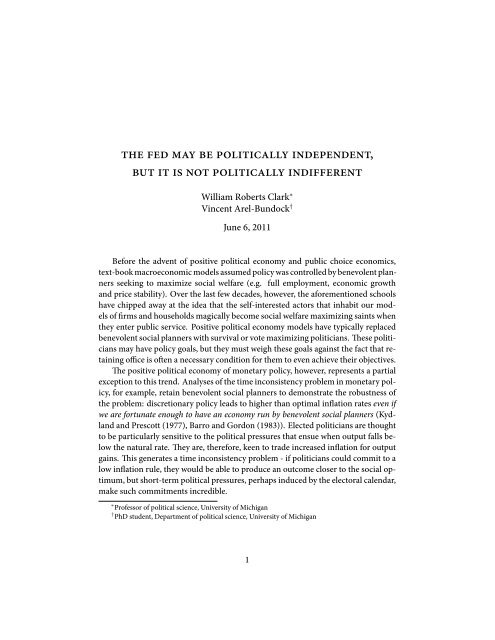
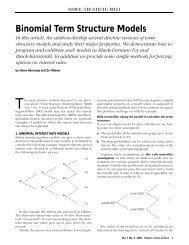
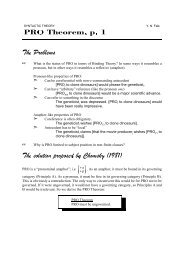
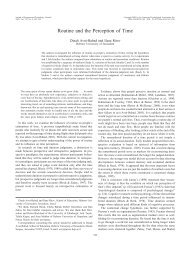
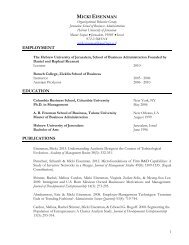
![CV [PDF] - Pluto Huji Ac Il](https://img.yumpu.com/18174585/1/190x245/cv-pdf-pluto-huji-ac-il.jpg?quality=85)

